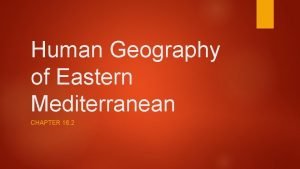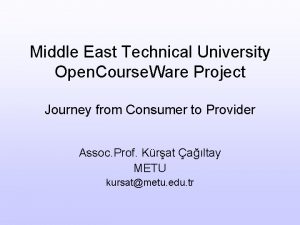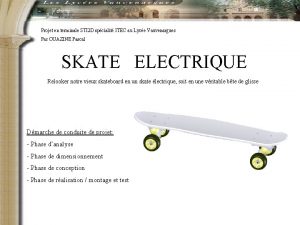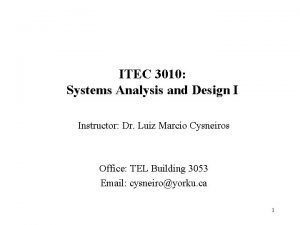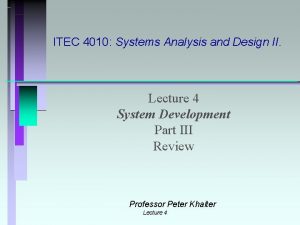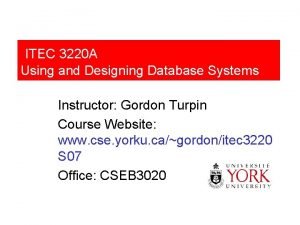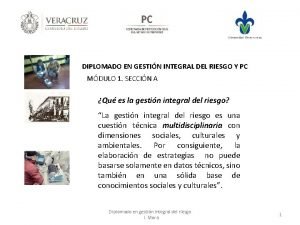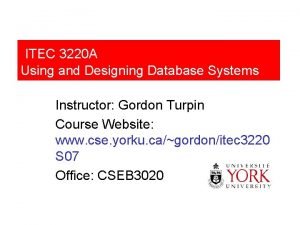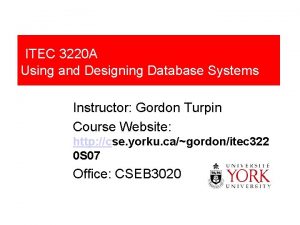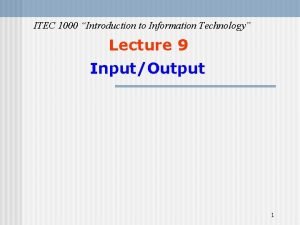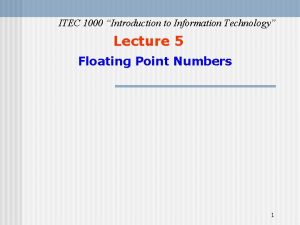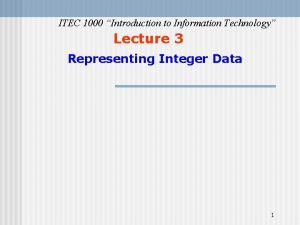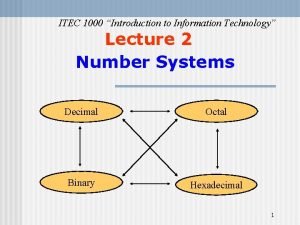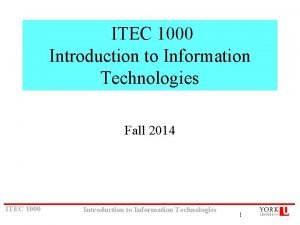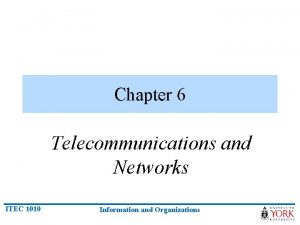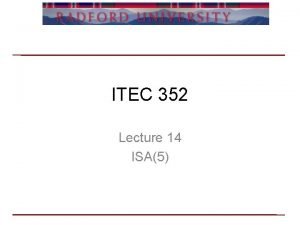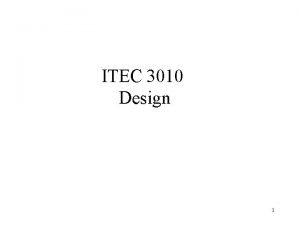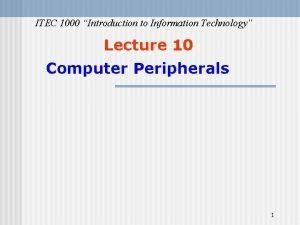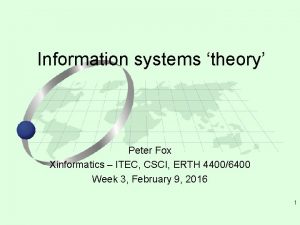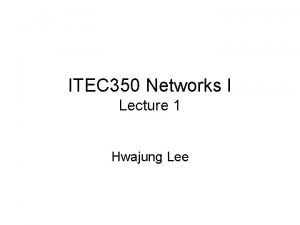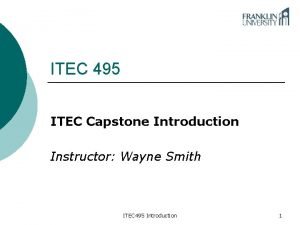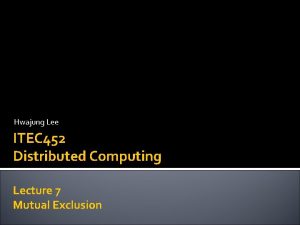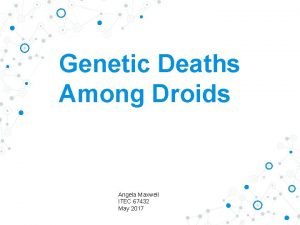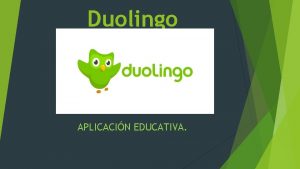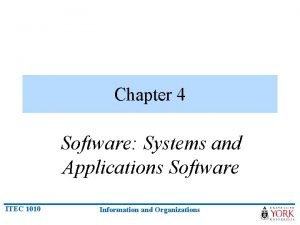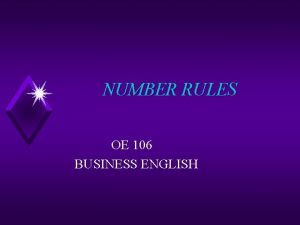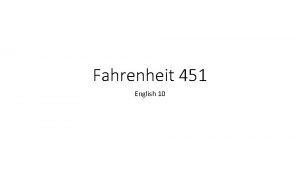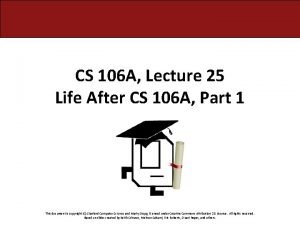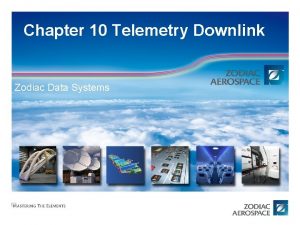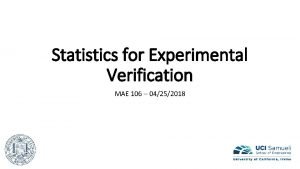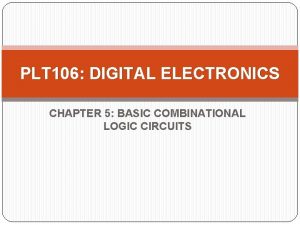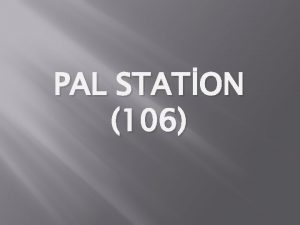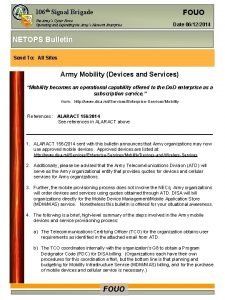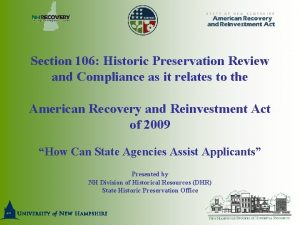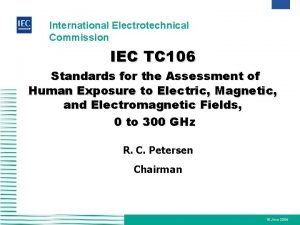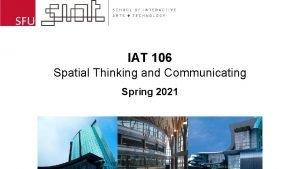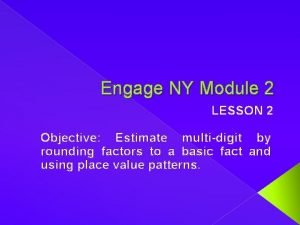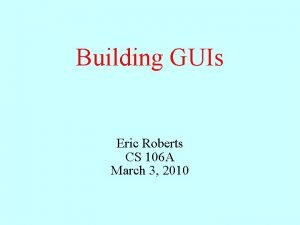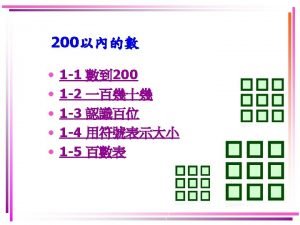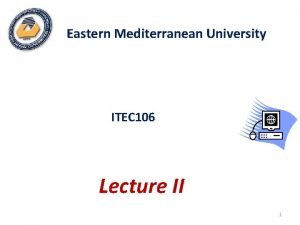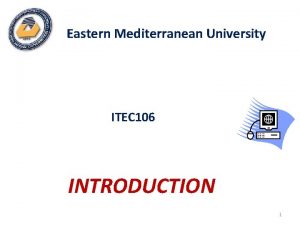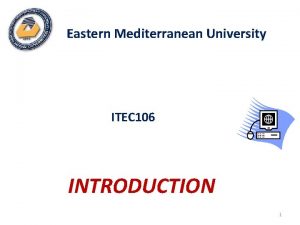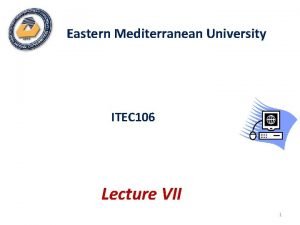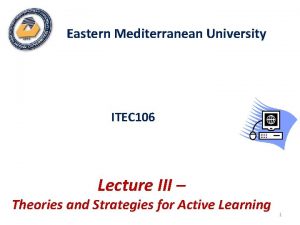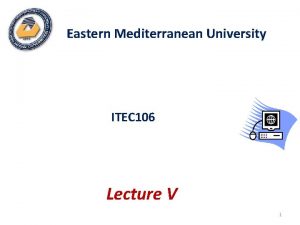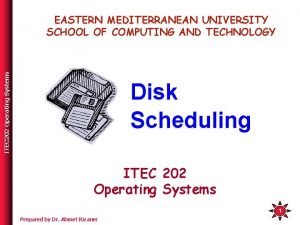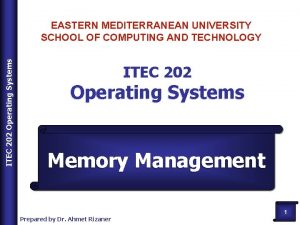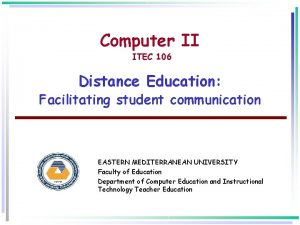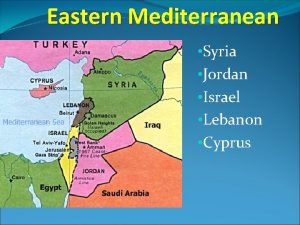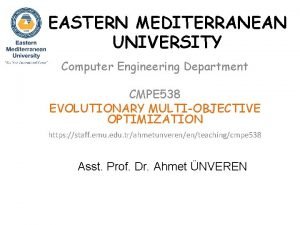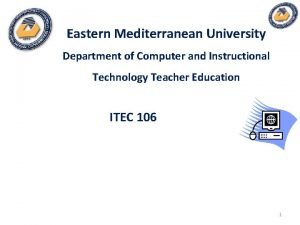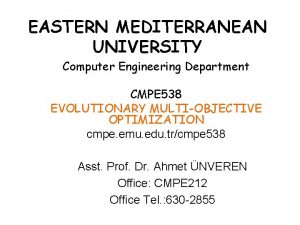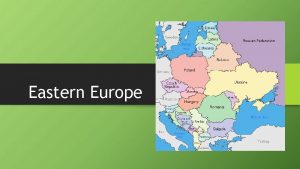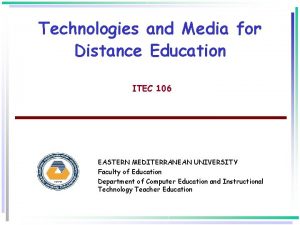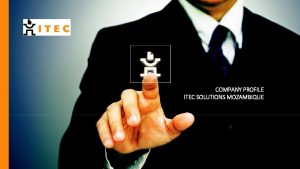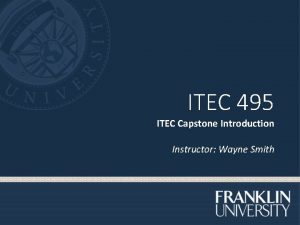Computer in Education ITEC 106 EASTERN MEDITERRANEAN UNIVERSITY

















































- Slides: 49

Computer in Education ITEC 106 EASTERN MEDITERRANEAN UNIVERSITY Faculty of Education Department of Computer Education and Instructional Technology Teacher Education

Today Topics q History of Computers in Education q Some terms q Computer Assisted Instruction q Use of Computers in Instruction q Instructional Methodologies and S/W q Selection of Instructional software -2 -

History of Computers q 1943 § ENIAC was constructed, finished in 1946, and turned off in 1955 for the last time. q 1945 § the term “bug” was coined by Grace Hooper when programming Mark II q 1949 § Claude Shannon builds the first machine that plays chess at the Massachusetts Institute of Technology -3 -

History of Computers… q 1949 § The Harvard-MARK III, the first of the MARK machines to use an internally stored program and indirect addressing, goes into operations again under the direction of Howard Aiken q 1950 § The first electronic computer is created in Japan by Hideo Yamachito -4 -

History of Computers… q 1953 § A magnetic memory smaller and faster than existing vacuum tube memories is built at MIT q 1955 § Dartmouth College’s John Mc. Carthy coins the term "artificial intelligence. " q 1963 § Doug Engelbart invents and patents the first computer mouse -5 -

History of Computers… q 1967 § IBM creates the first floppy disk. q 1975 § Paul Allen and Bill Gates write the first computer language program for personal computers, which is a form of BASIC designed for the Altair. Gates later drops out of Harvard and founds Microsoft with Allen. -6 -

History of Computers… q 1980 § IBM hires Paul Allen and Bill Gates to create an operating system for a new PC. The pair buy the rights to a simple operating system manufactured by Seattle Computer Products and use it as a template. IBM allows the two to keep the marketing rights to the operating system, called DOS. -7 -

History of Computers… q 1990 § Tim Berners-Lee, working with Robert Cailliau at CERN propose a 'hypertext' system, which is the first start of the Internet as we know it today. q 1997 § IBM’s Deep Blue computer defeats world champion chess player Garry Kasparov in their second six-game showdown, winning the tie-breaking game in only 62 minutes. -8 -

History of Computers in Education q Early use of computers in education are primarily on the field of: § mathematics § science § engineering q Mathematical problem-solving tool -9 -

History of Computers in Education… q Early History, 1940 s - 1970 s § when American researchers developed flight simulators which used analog computers to generate simulated onboard instrument data. q From these early attempts in the WWII era through the mid 1970 s, instructional software was directly tied to the hardware, usually mainframe computers. -10 -

History of Computers in Education… q 1959 § PLATO at University of Illinois § by Donald Bitier § first, large-scale project for the use of computers in education § enable computer-based instruction to integrate text and graphics, and provided instructors with one of the first programming environment for computer-based instruction -11 -

History of Computers in Education… q 1963 § Patrick Suppes and Richard Atkinson at Stanford § establish a program of research and development on CAI in math and reading. § develop an individualized, instructional strategies that allowed the learner to correct his responses through rapid feedback. § mastery is obtained through drill-andpractice -12 -

History of Computers in Education… q 1970 s § researchers were looking for new educational paradigms to take advantage of the breakthrough in computer technology. § developed paradigm: ICAI (intelligent CAI) -13 -

Some Terms q Instructional software § The application software serving for all teaching and learning activity can be thought as instructional software. q Courseware § Mainly focus on the teaching and learning of a certain content. § Courseware is a term that combines the words 'course' with 'software'. § The term's meaning and usage has expanded and can refer to the entire course and any additional material when used in reference an online or 'computer formatted' classroom. -14 -

Some Terms. . . q Edutainment § In a broader sense, the term edutainment describes an intentional merger of computer games and educational software into a single product. § In the narrower sense used here, the term describes educational software which is primarily about entertainment, but tends to educate as well. Software of this kind is not structured towards school curricula. -15 -

Relationship among those term Educational software Learning environment Instructional software Courseware Edutainment Learning tools -16 -

Introduction to Computer Aided Instruction Terminology Use of computer in education is referred by many names such as § Computer Assisted Instruction (CAI) § Computer Aided Instruction (CAI) § Computer Assisted Learning (CAL) § Computer Based Education (CBE) § Computer Based Instruction (CBI) § Computer Enriched Instruction (CEI) § Computer Managed Instruction (CMI) § IAC: Instructional Applications of Computers -17 -

CAI q stands for Computer Aided Instruction q an instructor-led, computer–based teaching aid. q the use of computer in the delivery of instruction. q the integration of software and hardware in instruction -18 -

What is CAI ? q A self-learning technique, usually offline/online, involving interaction of the student with programmed instructional materials. q Computer-assisted instruction (CAI) is an interactive instructional technique whereby a computer is used to present the instructional material and monitor the learning that takes place. q CAI uses a combination of text, graphics, sound and video in enhancing the learning process. q CAI refers to the use of the computer as a tool to facilitate and improve instruction. CAI programs use tutorials, drill and practice, simulation, and problem solving approaches to present topics and they test the student's understanding. -19 -

Arguments in Using Computers (Instruction) Ø Pro • Computers have endless supply of energy • Computers can be made available for longer period of time vs. human tutors • Computers, when properly programmed, are faster and more accurate than human instructors • Computers are capable of giving endlessly changing list of examples. -20 -

Arguments in Using Computers (Instruction)… Ø Against § computer instruction programs are notoriously poor in anticipating a students individual needs. § computer instruction programs are often more than rote exercises having scant educational values. § computer instruction programs have been very poor at adapting to the students changing abilities, and have locked the student into relatively rigid mode of instructions. -21 -

Use of Computers in Academe q As Tools q As Assistants q As Teachers -22 -

Computers as Tools q General purpose: § To automate tasks q Word processors § MS Word, Notepad, Wordpad, etc. q Spreadsheets § MS Excel, Lotus 123, etc. q Presentation Applications § MS Powerpoint, etc. -23 -

Computers as Assistants q General purpose: § For Assessment, Remediation, and Reinforcement q Applications § Drills § Instructional games § Simulations -24 -

Computers as Teachers q General purpose: § for Instruction, Remediation, and Assessment q Implementations: § CAI § ICAI § Tutorials § Simulations -25 -

Advantages of CAI q Interactive q Provides immediate feedback q Motivates learners q Provides consistency in presentation q Can adjust difficulty to the level of the learner -26 -

Advantages of CAI q Can present concepts or processes dynamically and using multiple forms of representation q Can maintain records of student performance q Can accommodate large number of learners. -27 -

Limitations of CAI q Repeated instruction. q Distribution. q Equipment and software can be costly. q Development takes time and money. q Lack of “personal touch”. -28 -

Development Tools q Programming Languages § Relatively inexpensive § Powerful and flexible § Difficult to learn and use § Ex: Pascal, C, Java, Visual Basic, etc. -29 -

Development Tools q Multimedia/Hypermedia tools § Relatively easy to learn and use § Relatively powerful and flexible § Moderately priced § Ex: HTML, Flash, etc. -30 -

Development Tools q Authoring Tools § Relatively easy to learn and use § Powerful and flexible § Expensive § Ex: Macromedia Authorware, Icon. Author, Quest, Pathware -31 -

Expository Model of Instruction q According to that model (EMI), for instruction to be effective the following four phases should be present: § § Presenting information Guiding the student Practicing by the student Assessing student learning -32 -

Expository Model of Instruction q Presentation of Information § “to teach something new, the instructor must first present information” § The instructor will perform the skills so that the students can imitate § methods: Examples § instructor-centered -33 -

Expository Model of Instruction q Guidance § interactive tutorial § Student performs under guidance of teacher § answers questions about factual info § apply rules and principles in problemsolving activities § practice procedural skills -34 -

Expository Model of Instruction q Guidance § the instructor observes the student, correct errors, and give suggestions or hints § Guided discovery is part of the guidance phase of instruction -35 -

Expository Model of Instruction q Practice § learner-centered § Instructor observes and corrects the student, but emphasis is on the student practicing and the instructor making only short corrective statements. -36 -

Expository Model of Instruction q Practice § Fluency, speed and practice § method: use of workbooks (arithmetic), flashcards (foreign-language instruction) -37 -

Expository Model of Instruction q Assessment § level of learning § quality of teaching § future instructional needs § method: tests -38 -

Instructional Methodologies and S/W q Tutorials q Drills q Simulations q Instructional Games q Tests § We will talk these and others next weeks -39 -

Instructional Methodologies and S/W… q Tutorials § teach new materials § typically they present information and then question the user to ascertain the level of learning achieved § able to monitor the student's progress and to present remedial or advanced levels if and when required -40 -

Instructional Methodologies and S/W… q Drills § typically deals with material that has already been taught § the student is presented with a task, often selected randomly, and feedback is offered immediately § able to keep pace with the student by offering remedial or advanced level if and when they become necessary -41 -

Instructional Methodologies and S/W… q Educational Games § may be tutorial/drill and practice/simulation with game elements added § learning elements are hidden -42 -

Instructional Methodologies and S/W… q Simulations § may be used to present information and guide the learner, to guide and drill, to do all three, or to test the student’s knowledge. § in here, the student learns by actually performing the activities to be learned in a context that is similar to the real world. -43 -

Instructional Methodologies and S/W… q Tests § assessed the level of learning § use for a variety of purpose: § Determine what a student knows and does not know; § Rank ordering of students in terms of performance; § Assigning grades; etc. -44 -

Instructional Methodologies and S/W… q Tests § Can take the form of an informal quiz or a strictly monitored examination where admission is by reservation only. -45 -

Major Types q Classification by relation with educational content Problem solving Quiry Individual instruction LOGO Micro world Drill-and-practice Excel Cast study Testing Simulation and game Dependent of content Relate with content E book Word Independent of content -46 -

Select Instructional software q STEP 1. Get Clear on using context: ANALYZE NEEDS and user § Needs & Goals. § Objectives. § Specify requirement. q. Step 2. Looking for Instructional software in resource library q. Step 3. Review all found software based on the Context getting in Step 1 -47 -

Select Instructional software q Step 4. Compare the selected educational software Select the most desirable software after a systematic evaluation of all alternatives in terms of educational objectives and constraints. q Step 5. Trial the selected software before using. -48 -

Thank you for attention -49 -
 Chapter 16 eastern mediterranean answers
Chapter 16 eastern mediterranean answers Eastern kentucky university aviation
Eastern kentucky university aviation University of eastern colorado firewatch
University of eastern colorado firewatch Middle eastern technical university
Middle eastern technical university Projet itec
Projet itec Ad systems exam slide
Ad systems exam slide Itec 4010
Itec 4010 Itec 3220
Itec 3220 Gestin itec
Gestin itec Itec 3220
Itec 3220 Itec 3220
Itec 3220 Itec 1000
Itec 1000 Itec 1000
Itec 1000 Itec 1000
Itec 1000 Itec 1000
Itec 1000 Itec 1000
Itec 1000 Itec 1010
Itec 1010 Itec exam results
Itec exam results First cut dcd
First cut dcd Itec 1000
Itec 1000 Itec irrigation controller
Itec irrigation controller Itec 350
Itec 350 Itec
Itec Itec
Itec Cs itec
Cs itec Bectra
Bectra Gestin itec
Gestin itec Qu es
Qu es Itec 1010
Itec 1010 106 spelled out
106 spelled out Fahrenheit 451 hook
Fahrenheit 451 hook Cs 106
Cs 106 Irig chapter 10
Irig chapter 10 Mae 106
Mae 106 Plt 106
Plt 106 106 pal
106 pal 106 signal brigade
106 signal brigade Error n-106
Error n-106 Section 106 compliance
Section 106 compliance Salmo 106
Salmo 106 Fas 106
Fas 106 Kj 106
Kj 106 Iec 62334
Iec 62334 Iat 106
Iat 106 Round the factors and estimate the products exit ticket
Round the factors and estimate the products exit ticket Roberts building 106
Roberts building 106 Round the factors and estimate the products exit ticket
Round the factors and estimate the products exit ticket 生命聖詩 106
生命聖詩 106 101 102 103 104 105 106 107 108 109 110
101 102 103 104 105 106 107 108 109 110 105 prime
105 prime
